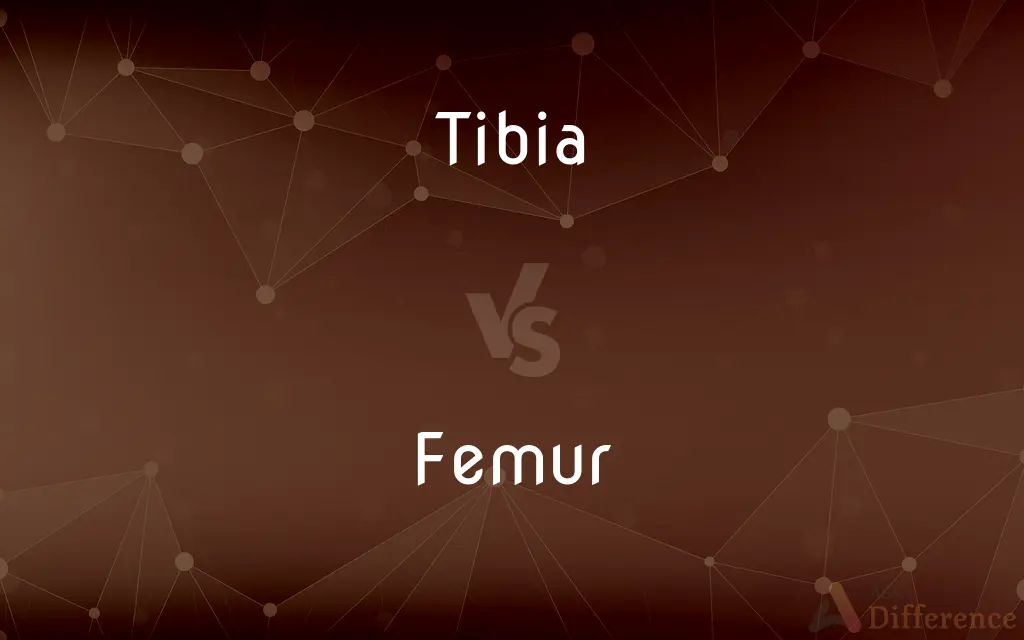Tibia vs. Femur — What's the Difference?
By Urooj Arif & Maham Liaqat — Updated on March 26, 2024
The tibia is the shinbone located in the lower leg, while the femur is the thigh bone and the longest bone in the body.

Difference Between Tibia and Femur
Table of Contents
ADVERTISEMENT
Key Differences
The tibia, also known as the shinbone, is one of the two bones in the lower leg, the other being the fibula. It is positioned on the medial side (closer to the center of the body) and plays a crucial role in supporting the body's weight and facilitating movement. The femur, or thigh bone, is the longest and strongest bone in the human body, connecting the hip to the knee and serving as a critical component of both the hip and knee joints.
In terms of structure, the tibia is a long bone with a triangular cross-section, providing significant strength for weight-bearing activities, while also allowing for muscle attachment. The femur has a rounded head that fits into the hip socket, a long shaft, and two protrusions at the knee end (the medial and lateral condyles) that articulate with the tibia and patella (kneecap).
Functionally, the tibia is essential for lower leg movements and bears a significant portion of the body's weight, particularly when walking or running. The femur not only supports the body's weight but also facilitates a range of complex movements at the hip and knee joints, such as walking, running, jumping, and squatting.
Injuries to the tibia, such as fractures, can significantly impact mobility and require a considerable amount of time to heal due to its weight-bearing function. Femur fractures are less common due to the bone's strength but are considered serious injuries that typically result from high-impact trauma and also have a prolonged recovery period.
The differences in their anatomical location, structure, and function underline the unique roles the tibia and femur play in the musculoskeletal system, each contributing to the body's mobility and stability in distinct ways.
ADVERTISEMENT
Comparison Chart
Location
Lower leg, medial to the fibula.
Thigh, between the hip and knee.
Function
Supports body weight, involved in lower leg movements.
Supports body weight, facilitates hip and knee movements.
Structure
Long bone with a triangular cross-section.
Longest bone in the body with a rounded head and a long shaft.
Injuries
Prone to fractures from impacts or stress.
Fractures usually result from high-impact trauma.
Role in Joints
Part of the knee and ankle joints.
Integral to both the hip and knee joints.
Compare with Definitions
Tibia
The inner and larger of the two bones in the lower leg, extending from the knee to the ankle.
She suffered a tibia fracture during the soccer game.
Femur
Connects the hip joint to the knee, playing a vital role in locomotion.
Hip fractures often involve the femur's head or neck.
Tibia
Prone to fractures due to its weight-bearing role and exposure in the lower leg.
Tibia fractures are common injuries in contact sports.
Femur
The longest and strongest bone in the human body, located in the thigh.
The femur's length contributes to its leverage and strength in leg movements.
Tibia
Participates in forming the knee joint with the femur and the ankle joint with the talus.
Arthritis in the knee often affects the area where the tibia meets the femur.
Femur
Its structure is designed to withstand the stresses of weight-bearing and movement.
Despite its strength, the femur can be fractured in severe accidents.
Tibia
A key structural component for lower limb support and movement.
The tibia's strength is crucial for weight-bearing activities like walking.
Femur
The femur is integral to the functioning of both the hip and knee joints.
Total knee replacements involve the femur's lower end.
Tibia
Essential for the attachment of muscles and ligaments involved in lower leg motions.
The tibia serves as an anchor point for several muscles that move the foot.
Femur
Subject to various medical conditions, including fractures, osteoarthritis, and osteoporosis.
Osteoporosis can make the femur more susceptible to fractures in older adults.
Tibia
The tibia (plural tibiae or tibias), also known as the shinbone or shankbone, is the larger, stronger, and anterior (frontal) of the two bones in the leg below the knee in vertebrates (the other being the fibula, behind and to the outside of the tibia), and it connects the knee with the ankle bones. The tibia is found on the medial side of the leg next to the fibula and closer to the median plane or centre-line.
Femur
The femur (, pl. femurs or femora ), or thigh bone, is the proximal bone of the hindlimb in tetrapod vertebrates.
Tibia
The inner and larger of the two bones of the lower human leg, extending from the knee to the ankle.
Femur
A bone of the leg situated between the pelvis and knee in humans. It is the largest and strongest bone in the body.
Tibia
A corresponding bone in other vertebrates. Also called shinbone.
Femur
A functionally similar bone in the leg or hind limb of other vertebrates. Also called thighbone.
Tibia
The fourth division of an insect's leg, between the femur and the tarsus.
Femur
The thick, most muscular segment of the insect leg, situated between the trochanter and the tibia.
Tibia
(Music) An ancient flute.
Femur
(anatomy) A thighbone.
Tibia
(anatomy) The inner and usually the larger of the two bones of the leg or hind limb below the knee, the shinbone
Femur
(entomology) The middle segment of the leg of an insect, between the trochanter and the tibia.
Tibia
(entomology) The second segment from the end of an insect's leg, between the femur and tarsus.
Femur
(arachnology) A segment of the leg of an arachnid.
Tibia
(arachnology) The third segment from the end of an arachnid's leg, between the patella and metatarsus.
Femur
The thigh bone; - it is the longest and thickest bone of the human skeleton, which extends from the pelvis to the knee.
Tibia
A musical instrument of the flute kind, originally made of the leg bone of an animal.
Femur
The longest and thickest bone of the human skeleton; extends from the pelvis to the knee
Tibia
The inner, or preaxial, and usually the larger, of the two bones of the leg or hind limb below the knee.
Tibia
The fourth joint of the leg of an insect. See Illust. under Coleoptera, and under Hexapoda.
Tibia
A musical instrument of the flute kind, originally made of the leg bone of an animal.
Tibia
The inner and thicker of the two bones of the human leg between the knee and ankle
Common Curiosities
Can you fracture both the tibia and femur in the same accident?
Yes, high-impact traumas, such as car accidents or severe falls, can cause fractures to both the tibia and femur.
How long does it take for a tibia fracture to heal?
Healing times vary, but tibia fractures typically require several weeks to months to heal completely, depending on the severity and treatment method.
What role does the tibia play in the knee joint?
The tibia forms the lower part of the knee joint, articulating with the femur above and providing stability and support for the joint.
Why is the femur considered the strongest bone in the body?
Its length, dense structure, and role in supporting the entire body's weight contribute to its strength.
Can diseases affect both the tibia and femur?
Yes, diseases like osteoporosis and arthritis can affect both bones by weakening the bone structure or degrading the joint surfaces, respectively.
How do the tibia and femur contribute to walking?
Together, they provide the structural support and joint mechanisms necessary for the leg to bear weight, balance, and move, enabling walking and running motions.
Are femur fractures more complicated to treat than tibia fractures?
Femur fractures can be more complex due to the bone's size, the forces needed to break it, and its critical role in the hip and knee joints, often requiring surgical intervention.
What materials are used in the surgical repair of femur fractures?
Surgical repairs often use metal rods, screws, and plates to stabilize the bone and facilitate healing.
What distinguishes the tibia from the femur?
The tibia is located in the lower leg and primarily supports weight and facilitates lower leg movements, while the femur is the thigh bone, known for being the longest bone that supports body weight and enables hip and knee movements.
What is the significance of the femur's head in hip joint health?
The femur's head fits into the hip socket, forming the ball-and-socket joint of the hip, crucial for a wide range of movements and stability.
What activities can increase the risk of injuring the tibia or femur?
Activities with high physical impact, such as contact sports, skiing, and high-altitude sports, can increase the risk of fractures to these bones.
How are tibia and femur fractures diagnosed?
Fractures are typically diagnosed through physical examinations and imaging tests like X-rays or MRIs to assess the extent of the injury.
Share Your Discovery

Previous Comparison
Souvlakia vs. Souvlaki
Next Comparison
Modernization vs. ModernismAuthor Spotlight
Written by
Urooj ArifUrooj is a skilled content writer at Ask Difference, known for her exceptional ability to simplify complex topics into engaging and informative content. With a passion for research and a flair for clear, concise writing, she consistently delivers articles that resonate with our diverse audience.
Co-written by
Maham Liaqat













































